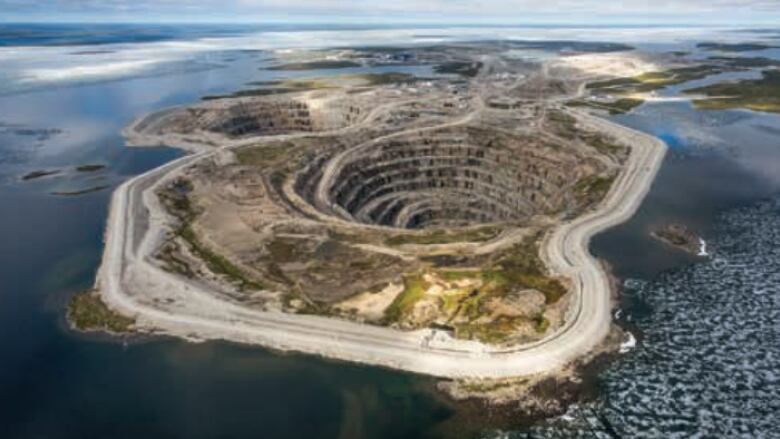Diavik mine owner appeals to N.W.T. minister for help in regulatory dispute
Dike construction around future pit 'challenging' under current licence conditions: company

The company operating the Diavik diamond mine says the denial of achange to its water licence could have an "immediate and materially-adverse impact" on the mine.
Now the company is appealing to the N.W.T.'s Minister of Environment and Natural Resources for a chance to air its concerns.
Diavik Diamond Mines Inc. (DDMI), the Rio Tinto subsidiary that operates Diavik, is building a new, $456-million pit insideLac de Gras, located about 300 kilometres northeast of Yellowknife. The pit, called A21,is expected to help the mine remain open until at least 2024.

Last summer, during construction ofthe dike that will enclose thepit, the malfunction of a siltcurtain caused the level of total suspended solids (TSS) in one area of the lake to go over the regulated limit of 25 milligrams per litre.
That's the limit that remains protective of all aquatic life, as established by the Canadian Council of Ministers of the Environment.
Inspector threatens construction shutdown
The exceedance last summerprompted a stern warning from an inspector with the N.W.T. government.
"Should any further exceedances occur the inspector will have no alternative but to terminate the source of the high TSS," Tracey Covey, an inspector with the N.W.T. Department of Lands, wrote toDDMI.
"This will be achieved through termination of dredging and other A21 related in-water construction activities."

DDMIsays TSS concentrations during dikeconstruction are affected by variables outside the company's control, such aswind speed, wind directionandlakecurrent.
Citing a concern that the upcoming 2016 dike construction season will be "more challenging" than last year's when it comes to managing TSS,DDMI is asking that the TSS limit be relaxed.
In essence, the company wants the level of TSS to be measured using a 30-day average, instead of goingday by day.
Board sticks with current limit
Last week, however, in a recommendation to N.W.T. Environment MinisterWally Schumann,the Tlicho region'sWek'eezhii Land and Water Boardsaid the existing daily limit of 25 milligrams per litre should remain in place.
DDMI has now written toSchumann directly.
Citing "serious concerns" with the board's decision which needs to be approved by the ministerLouis Bland, a lawyer for DDMI, wrote, "We respectfully request that you defer your decision to approve the amendment or not until we have had a chance to communicate in more detailwhy the proposed amendment is so problematic and to investigate the options available to us."
"There is no urgency that would justify rendering an immediate decision,"Bland added.
No one from DDMI was available for an interview Wednesday.
Ryan Fequet, the executive director of theWek'eezhiiLand and Water Board, says DDMI has had the opportunity to weigh in on the issue
"Theboard's process includes a series of opportunities for parties to submit evidence (comments, concerns, support for, recommendations, etc.) on the proposed amendment," he wrote via email."The board's recommendation is now with the minister for his consideration."
DDMI's construction schedule calls for the dike around A21 to be enclosed this year and for production from the A21 open pit to begin in 2018.
Construction of the dike employed 97 people last year. A quarter of those people were aboriginal and from the North.












_(720p).jpg)


 OFFICIAL HD MUSIC VIDEO.jpg)
.jpg)



























































































